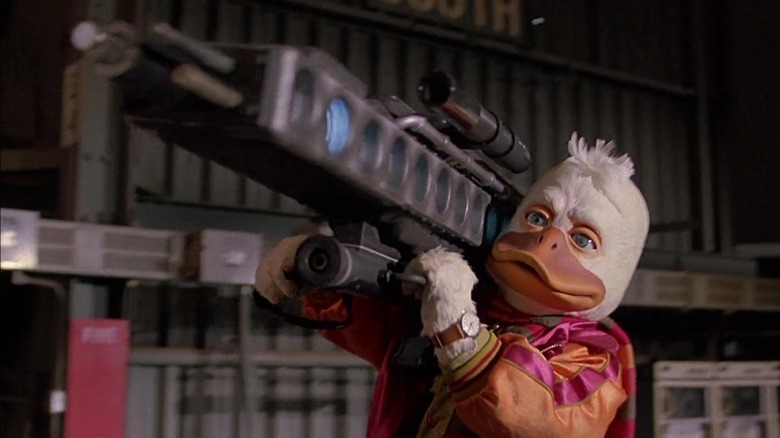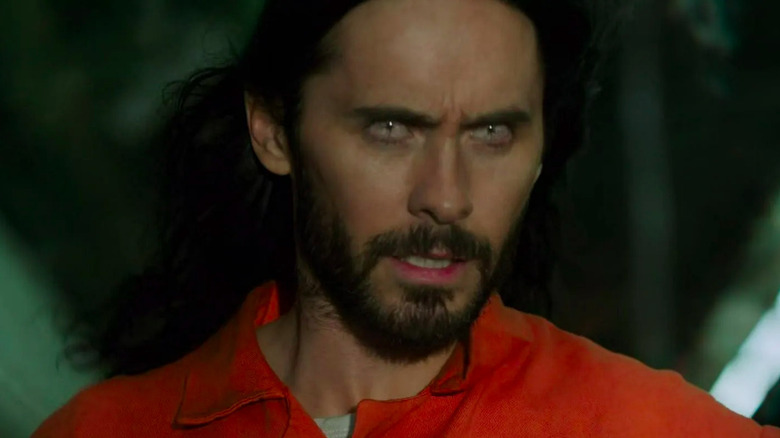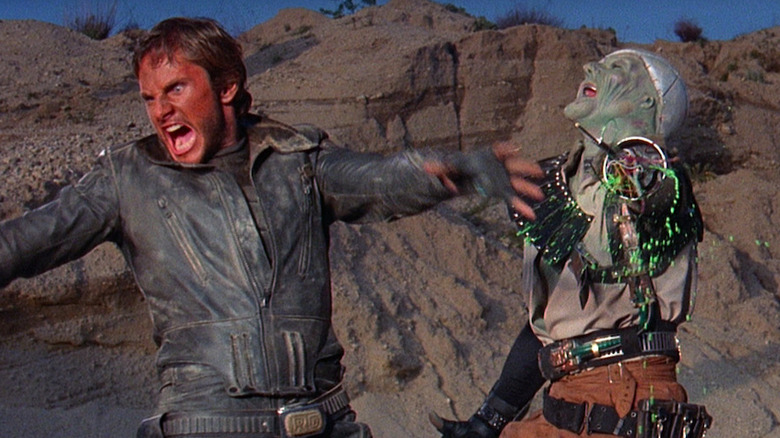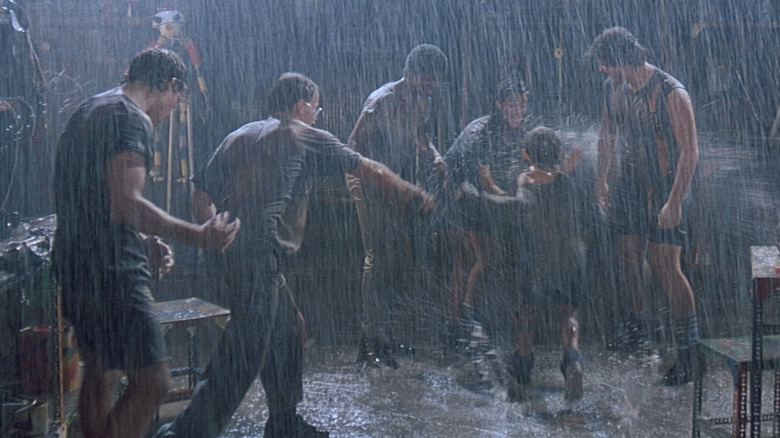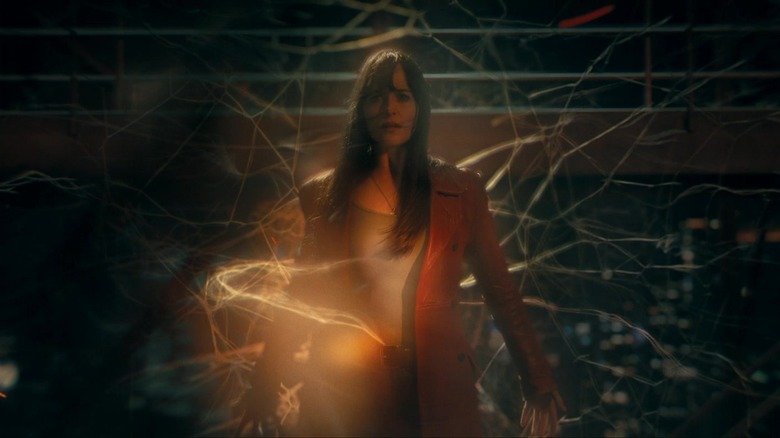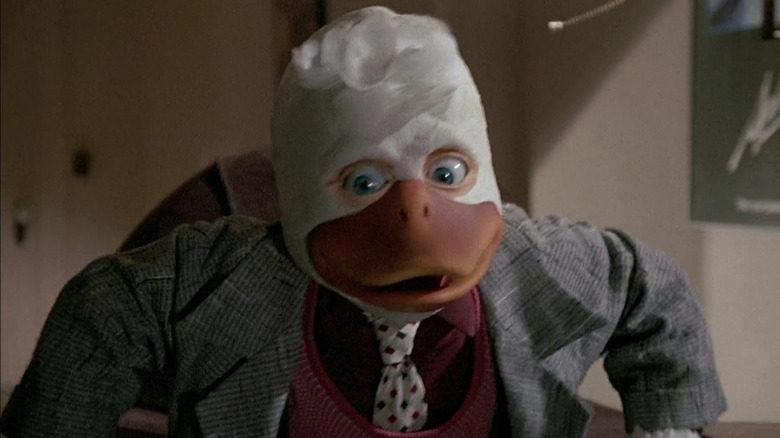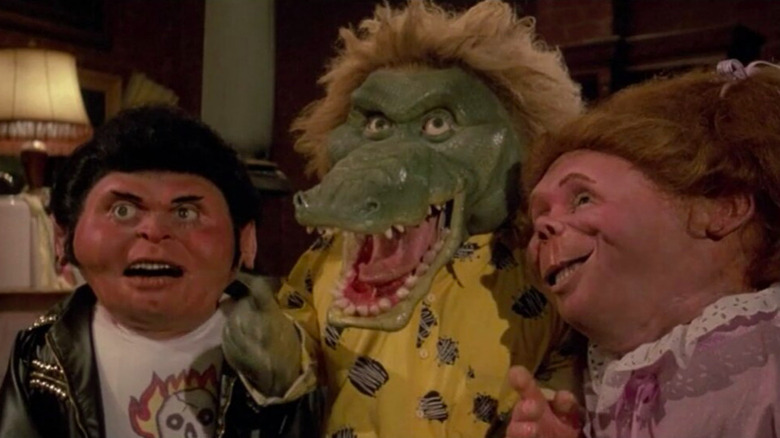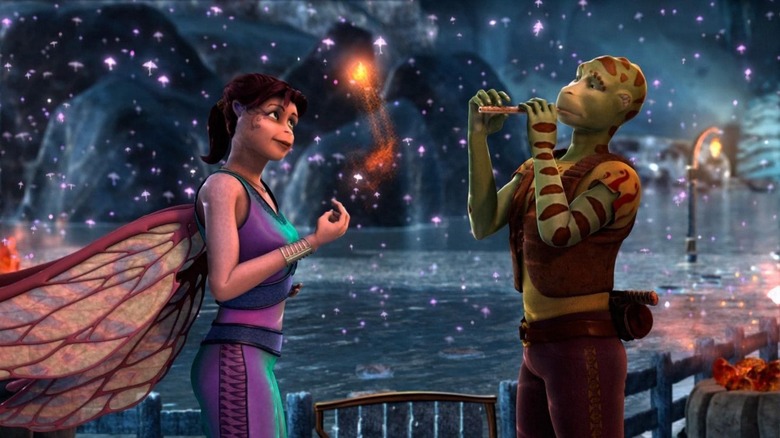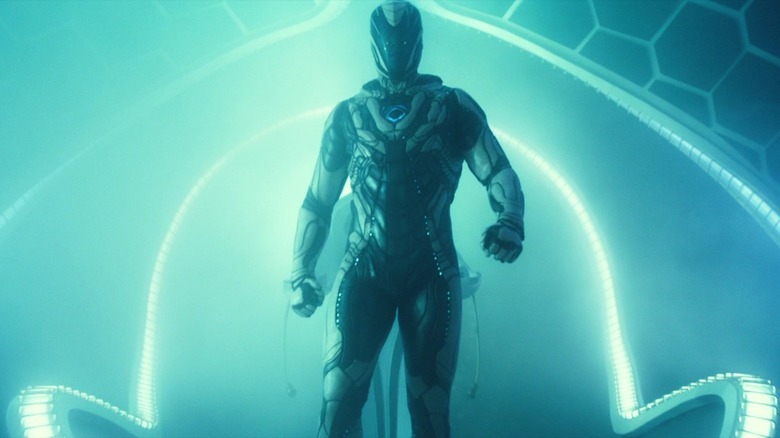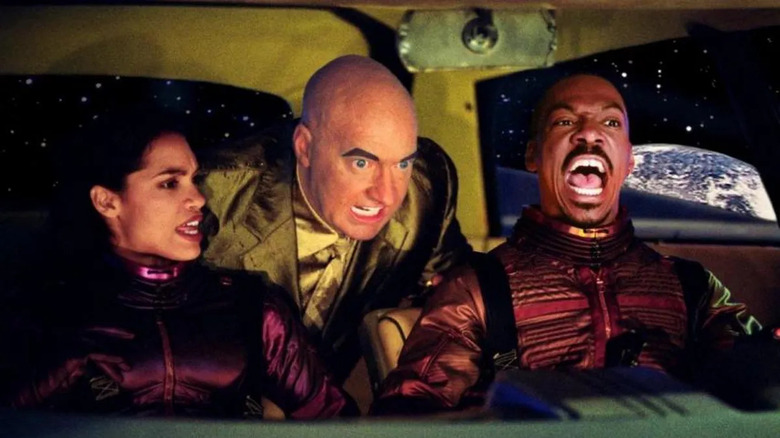Sci-Fi Movies So Bad They Were Pulled From Theaters
Comparing box office runs over the past decades is a tricky, because the movie business has undergone so many shifts. Around 40 years ago, a typical theatrical run could be 6 to 12 months, as films typically debuted in large urban centers before eventually being distributed to smaller towns and rural areas. It seems impossible now, but in the time before the widespread adoption of home video and pay cable, it could be years between a film's theatrical run and a home viewing experience. "Star Wars" (1977) was first released on video (VHS and Betamax) in the United States in May 1982, five years after its May 1977 premiere, and it would appear on pay cable nine months later before finally airing on American broadcast TV on February 26, 1984.
These new technologies drastically altered the marketplace, making "I'll wait for it on video" a perfectly reasonable decision. The digital revolution of the 2000s further accelerated this trend. Streaming platforms allow viewers to access new releases from home, leading to even shorter theatrical windows, as studios prioritize digital releases for broader reach, which has a hurtful impact on independent movie theaters.
The result is an unforgiving marketplace where a theatrical run can and will be cut short by either the distributors or the theaters themselves. As the gap between theater screen and TV screen has become vanishingly small, bad movies get whacked faster than ever. But studios have been pulling bad or underperforming movies from theaters for years.
Here are 10 sci-fi movies that were quickly pulled from theaters.
Morbius (2022)
It's not often that a movie gets to bomb twice.
The Sony Pictures release "Morbius" opened very wide on 4,268 screens. But as soon as their initial commitments were up, theaters began dropping it. Eight weeks into its release, it was showing on only 83 screens, and in that time on all those screens, it barely grossed its budget domestically.
Normally, that would have been that, but "Morbius" was the flop that spawned a million memes. The movie was skewered endlessly and often hilariously on the Internet. A #MorbiusSweep movement emerged that exaggeratedly praised the film's performance, ironically pretending that it was a massive success. Let's face it, 2022 was truly the year of Morbius.
But Sony wasn't in on the joke. It assumed any kind of publicity was good publicity. It misread all the social media mocking as interest in the failed film itself, and saw all the attention as a means to get butts into theater seats, So, 10 weeks after its original dismal debut, they re-released "Morbius" only to see history repeat itself in a more embarrassing fashion. The movie went from 83 screens to 1,017, and this time it bombed so hard that Sony yanked the film after only a week, proving you can't force a movie into cult classic status.
Metalstorm: The Destruction of Jared-Syn (1983)
Empire Pictures founder Charles Band's ("Puppetmaster," "Trancers") early 1980s productions were low-budget genre films with lots of technical shortcomings, typically hampered by weak scripts and inconsistent direction. They're mostly not good, but some hold a certain charm for fans of B-movies.
This isn't the case across the board. Take 1983's sci-fi action flick "Metalstorm: The Destruction of Jared-Syn" (please). It's poster boldly proclaims, "It's High Noon and the end of the Universe." In reality, it was a muddled mash-up of Westerns, "The Road Warrior," and "Star Wars." Universal picked up for distribution to theaters they'd hoodwinked into showing their abysmal "Jaws 3D," yet another attempt to cash in on the era's brief 3-D craze. "Metalstorm" film was seen by many as a lower-rent version of "Spacehunter: Adventures in the Forbidden Zone," another 3D picture that opened three months prior and cost nearly six times as much.
Universal opened "Metalstorm" in 549 theaters, but its average run in each was a mere 2.3 weeks, as demonstrated by losing 91% of screens by its 19th day. Despite being junked by most theaters, the film managed to scrape in $5.3 million against a reported $2.5 million budget. That sounds like a profit, until one takes into account the prints and advertising budget, and the exhibitor and distributor cuts of the box office take.
Solarbabies (1986)
What doomed "Solarbabies"? The merits — or lack thereof — of the movie aside, let's start with the doubly stupid name. What do people think of when they see "Solarbabies" as the title of a movie? Toddlers in the sun? Who's lining up for that? Given its dystopian setting and roller-skate central sport, they might as well have named it "Solarball" and had James Caan make a cameo.
The film wasn't a huge release, opening in less than half the theaters that "Howard the Duck" did three months earlier. It was a box office nothing, averaging just 1.8 weeks per theater before being dumped, shedding a whopping 75% of its venues in less than two weeks.
Critics slammed its plot and special effects. Audiences didn't latch onto its post-apocalyptic storyline and mix of sci-fi and adventure either. It also had the misfortune of opening the same day as "Star Trek IV: The Voyage Home." By the time Eddie Murphy's "The Golden Child" premiered 16 days later, "Solarbabies" had already shed three-quarters of its screens. It's enough to make a grown distributor cry ... like a big fat Solarbaby.
Madame Web (2024)
Except for "Guardians of the Galaxy Vol. 3," every superhero movie in the past year has underperformed, and Sony's Spider-Man universe entry "Madame Web" is the new poster child for this. It bombed. Hard. So hard that the Hollywood Reporter was writing its epitaph days after its Presidents Day weekend opening. All told, the $80 million (or more) flick grossed just over $102 million worldwide before disappearing from theaters, making it one of the biggest box office flops of 2024 so far.
This wasn't just exhibitors dropping it, because only 30 days after it opened, the film was available for digital download! Plenty of the usual reasons were suggested for this flop, including accusations that the film was review-bombed by people who'd never — and never would — watch it. Whatever the veracity of those claims, it was a critical dud amongst both professional and citizen critics alike.
Despite its box office woes, Sony & Marvel's "Madame Web" made quite a splash on Netflix charts. From May 13–19, "Madame Web" was number one on Netflix's U.S. Top 10 Movies chart and in the Top 10 movies chart in Bangladesh, India and Pakistan. Whether streaming and home video sales make a dent in its deficit is something we may never know.
Howard the Duck (1986)
Forget Sam Rami's "Spider-Man" (2002), "Iron Man" (2008), or the never officially released "The Fantastic Four" (1994). "Howard the Duck" was the first blockbuster attempt at a Marvel movie (even though it wasn't technically the first Marvel movie overall).
Created by writer Steve Gerber and artist Val Mayerik, Howard the Duck appeared in Marvel Comics from late 1973 to 1980, following the adventures of this anthropomorphic duck in a human-dominated world. This absurdist and irreverent noir mined social and political themes through Howard's misadventures. So when a film adaption was announced with George Lucas as executive producer with his "American Graffiti" co-writers Willard Huyck and Gloria Katz penning the screenplay, there was considerable anticipation.
But the film was a mega-misfire, starting with Howard himself, inexplicably redesigned to be cute and bearing little resemblance — both physical or personality-wise — to the source material. The film was savaged by critics and audiences alike, and it won four Golden Raspberry Awards (Razzies), which recognize the worst movies in a given year.
Theaters dropped "Howard the Duck" like a hot potato, The film opened in over 1,500 theaters, but after only four weeks, 80% of them dumped it. The average per-theater exhibition was a pathetic 2.8 weeks. Its worldwide box office was almost close to its total budget, but that didn't mean it broke even. A film typically had to earn two to three times its budget to do that, since the exhibitors keep a portion of ticket sales and the prints and advertising budget must be recouped.
Jem and the Holograms (2015)
The act of adaptation from one medium to another is a tricky thing, and when the source material is a decades-old piece of pop culture whose presumptive audience relishes in the memory of something they loved as children, the task becomes perilous. Hewing to source material beloved by the nostalgia crowd risks alienating a broader audience, but changing things up to be more contemporary is to risk the wrath of the fandom the material most appeals to.
Such a no-win scenario faced the makers of "Jem and the Holograms," the 2015 live-action feature based on the syndicated 1980s series "Jem." The filmmakers opted to update and alter the material to make it more "now" (Jem initially finds success via YouTube). As the Grail Knight from "Indiana Jones and the Last Crusade," might say to the filmmakers, "You have chosen poorly."
How poorly? In 2018 Variety called it one of the four worst wide releases ever. Business Insider reported the film opened wide on 2,417 screens, and two weeks later, it was down to about 50, a drop of roughly 98%! In its opening week, it averaged only $160 per screen. In the mercifully quick end, its total gross was a mere $2.4 million worldwide against a $5 million budget.
The Garbage Pail Kids Movie (1987)
If any film was destined for the trash heap, it was this one. The Garbage Pail Kids was a highly successful bubble gum card fad in the 1980s, a comically cynical response to the insanity of the then-recent Cabbage Patch Kids mania and designed to appeal to children's taste for tastelessness. But by the time of the movie's release, the cards were a fading fad, uptight parents controlled the allowances of its presumptive child audiences, and the film was a mess.
Parents raised a stink over the film's subject matter. Critics universally canned it. It opened only in major markets, earning only $661,000. Now that's box office gross. It's widely believed the film was pulled by its distributor, Atlantic Releasing, but it shed 281 of its initial 374 theaters after its first week. By the following week, it dropped to a paltry 48 screens in four cities. It wasn't so much yanked as junked by theaters. Nine years later, Tim Burton's 1996 "Mars Attacks!" would similarly — though more successfully — adapt bubblegum cards into a feature film, but it didn't exactly set the world on fire, either (Ack! Ack!).
Some might debate the sci-fi credentials of this right from the rubbish bin feature. But its title sequence features a garbage pail spaceship, which suggests these trading card kids are things from another world, and the story certainly dabbles in the fantastical ... while being the opposite of fantastic.
Delgo (2008)
"Delgo" was the little Indie that couldn't. An independent CGI animated feature that dared to take on the big guns. Though its celebrity the voice cast included Freddie Prinze Jr., Jennifer Love Hewitt, Chris Kattan, Anne Bancroft, Eric Idle, Val Kilmer, Lou Gossett Jr, Malcolm McDowell, Michael Clarke Duncan, Burt Reynolds and Kelly RipaI, it took almost a decade to come to fruition, only to crash and burn.
The $40 million film opened in 2,160 theaters but earned just $237 per theater (about 11 people per day) in its opening weekend. It was gone from theaters so fast that it appeared only once in industry trade Variety's Box Office Report, and websites reporting its earnings have only six days of figures.
What went wrong? Well, everything. Pixar-wanna-be Fathom Studios tried to go from zero to "Toy Story" without knowing how to make a movie. There was a woeful lack of experience in the production team and amongst the writers. Variety's review said, "Somehow it took six writers, including co-directors Marc F. Adler and Jason F. Maurer, to fashion a script that lacks a single original thought, story idea or gimmick."
Arriving in theaters amidst a glut of Christmas holiday films was the final indignity. The prolonged development meant that what might have been passable CGI in 2002 was offered to non-existent audiences seven years too late. The character designs were panned, the sound was a mess, the marketing was non-existent, and "Delgo" was gone from most theaters in a week.
Max Steel (2016)
The history of Hollywood repeatedly demonstrates that movies based on toys aren't a sure thing. Greta Gerwig's Barbie recently broke every single Hollywood rule about toy movies and became a massive hit, whereas another Mattel toy that made the leap — or is that stumble — to the silver screen didn't. We're talking about 2016's "Max Steel."
"Max Steel" was simultaneously developed as both a toy line and an animated TV series. The former hit shelves in 1999 and the latter hit screens the following year. Also, a series of 48-ish minute-long "movies" were made for video. Then, capitalizing on the superhero boom of the first decade of MCU films and the box office success of the first "G.I. Joe" and "Transformers" films, the "Max Steel" franchise was greenlighted for a live-action motion picture.
The result? "Max Steele" was a Max Bomb. Though it opened wide on over 2,000 screens, it made a single appearance in Variety's Film Box Office Grosses for its opening weekend, then vanished utterly. Bomb Report states the film cost about $20 million after tax rebates; worldwide it grossed under a quarter that. After three weeks playing to virtually empty houses it was pulled from theatrical distribution. Two and a half months later it was available on home video.
The Adventures of Pluto Nash (2002)
I don't know if anyone's ever employed Henry Wadsworth Longfellow's rhyme "There Was a Little Girl" to describe Eddie Murphy's cinematic output, but one can paraphrase its second half as, "When he was good, he was very, very good, but when he was bad, he was horrid." You can guess at which extreme "The Adventures of Pluto Nash" crash lands.
Not that anyone was really surprised. "Pluto Nash" reeked of failure long before it finally opened. The concept for the film was hatched 20 years earlier, and the project went through development hell and back multiple times with several directors attached before finally going before cameras in 2000. In an interview with /Film, director Ron Underwood ("City Slickers") said Murphy rejected script after script, saying "I want it to be just kind of straight, and I'll bring the comedy."
An early 2001 test screening of the film in an unfinished state was savaged by Ain't It Cool News. This set the expectation that "Pluto Nash" was more of a dog than Disney's Pluto pup. Reshoots were ordered, and it would be two years after it originally wrapped before the finished product emerged.
The resulting film was almost as bad as anticipated. It was unceremoniously dumped into over 2,000 theaters, which in turn dumped it en masse. "Pluto Nash" and his adventures averaged a mere 2.8 weeks per theater. It lost so much money that it's one of the most expensive sci-fi flops In history.
